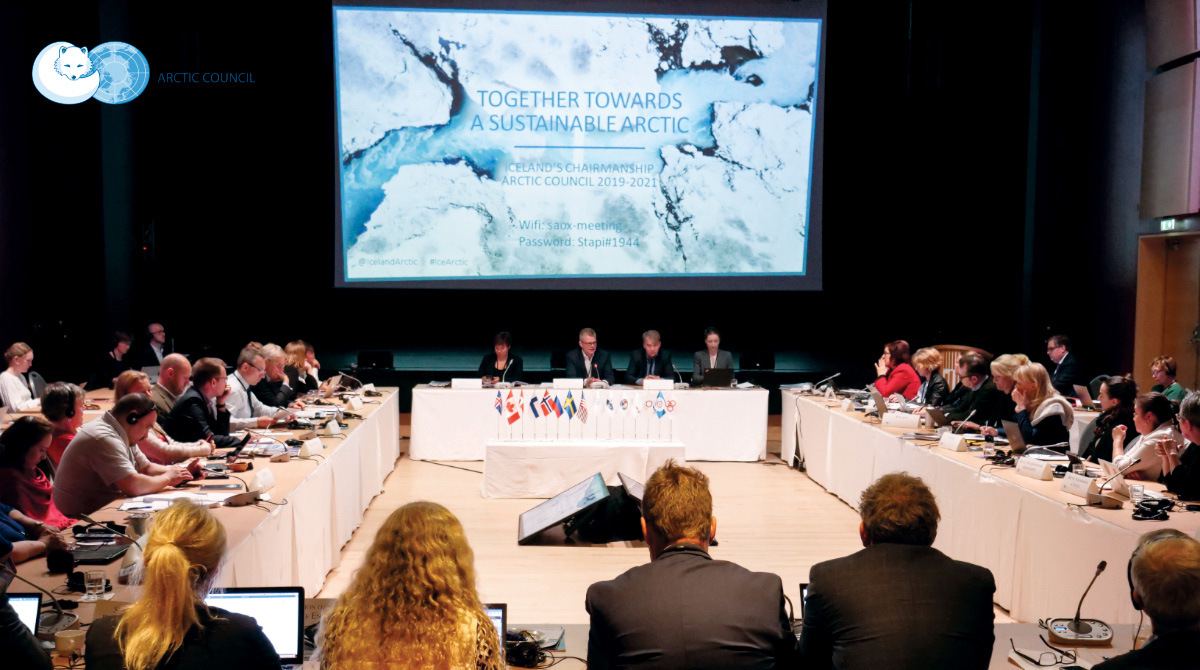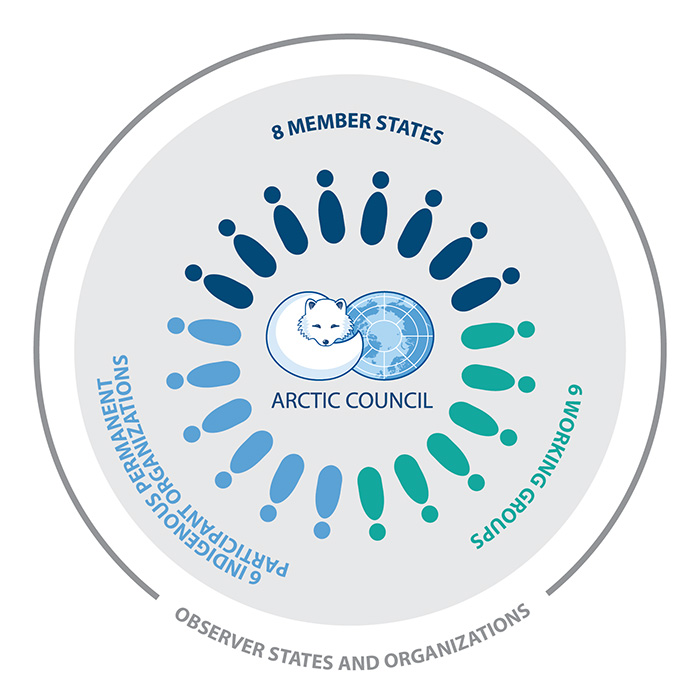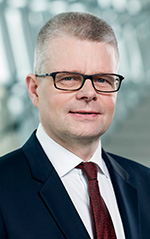Toward a Sustainable Arctic
Iceland has worked to address priority challenges—economic growth, social inclusion and environmental protection—during its chairmanship of the Arctic Council.
BY EINAR GUNNARSSON

Senior Arctic Officials of the Arctic Council meeting in Reykjanesbær, Iceland, in June 2019.
Courtesy of Einar Gunnarsson
Iceland has chaired the Arctic Council for the past two years and is preparing to hand over the gavel to Russia at a ministerial meeting in Reykjavík this month. During our chairmanship, we wanted to call attention to the core mission of the Arctic Council since the signing of the Ottawa Declaration in 1996: Sustainable development and the importance of balancing its three pillars—economic growth, social inclusion and environmental protection. In a rapidly changing world, we see the value of remembering and reflecting on our starting point.
With that in mind, we chose sustainability as the overarching theme of our two-year term, and “Together Toward a Sustainable Arctic” as the title for our chairmanship program.
The Heat Is On
Those of us in the Arctic already feel the effects of climate change, and appreciate that it is a real global threat, growing at an unprecedented scale. As such, it calls for worldwide mitigation actions. Even if the best-case scenario plays out, with a fully implemented Paris Agreement, we can still expect to see temperatures rise in the Arctic region by at least 3 to 5 degrees Celsius by the middle of the century, with unforeseen negative consequences.
It is therefore crystal-clear that we need stronger global action and cooperation to reduce emissions, along with increased adaptation efforts, to deal with the drastic impact climate change is already having on our region.
To help us in this battle, we must strike a balance among economic growth, social inclusion and environmental protection. These three pillars of sustainable development are also clearly reflected in Iceland’s four chairmanship priorities: the Arctic marine environment, climate and green energy solutions, the people and communities of the Arctic and, last but not least, a stronger Arctic Council. We believe that these four areas serve to highlight some of the most pressing issues facing the Circumpolar North today.
The Big Blue

Diagram of the structure of the Arctic Council.
Arctic Council Secretariat
Oceans cover a large portion of the Arctic, and a vast majority of Arctic communities are shore-based but owe their livelihoods to ocean-based activities. The Arctic states therefore have a duty and responsibility to safeguard the Arctic Ocean, which the council’s working groups have significantly advanced through increased scientific knowledge and understanding of the marine environment. This focus on oceanic matters and the Arctic marine environment is one of the links between Iceland and the United States, as shown by the fact that the United States concentrated on the same two issues during its own chairmanship (2015-2017).
Iceland has built on the work accomplished then; inter alia, the Arctic Council has launched a new platform for discussing Arctic marinerelated topics: the Senior Arctic Officials Marine Mechanism. We hope that the SMM will become an annual gathering of marine leaders and experts under the auspices of the council, contributing to informing senior Arctic officials’ work and enhancing circumpolar cooperation on the Arctic marine environment.
Even though our focus has been, and will remain, the emerging and ongoing challenges climate change presents, there are opportunities to be found, as well. The melting sea ice is gradually opening up new sea routes, giving better access to natural resources and prompting an increase in Arctic tourism. We already have regular sea routes between Iceland and four U.S. ports; one of those, Portland, Maine, is sometimes called the United States’ eastern gateway to the Arctic.
In 2014 the government of Iceland and the state of Maine signed a memorandum of understanding outlining a desire to increase cooperation in business development, transport, logistics and culture. It also called for further cooperation on such Arctic-related issues as environmental security and searchand- rescue operations. Evidently, there is real potential to build sustainable business opportunities in the Arctic, and for Iceland and the United States to strengthen our cooperation by building on these opportunities together.
Even though our focus has been, and will remain, the emerging and ongoing challenges climate change presents, there are opportunities to be found, as well.
The New England Ocean Cluster in Portland, inspired by the Icelandic Ocean Cluster in Reykjavík, is a good example of an innovative “blue economy” consulting project creating new opportunities for cooperation. The aim of the “Ocean Cluster” groups is to connect people within the ocean economy, and to encourage an innovative and sustainable approach to realizing economic opportunities. The “ocean cluster” concept has a direct link to work in the “blue bioeconomy” area, which focuses on the use and conversion of living aquatic resources into a wide variety of products and services such as food, feed, biobased materials and bioenergy.
In Iceland, we have seen successful companies born out of this methodology. One of them has even developed a method for extracting enzymes from fish skin that is revolutionizing the treatment of chronic wounds.
Sustaining Sustainability
For the past quarter-century, sustainable development has been at the heart of our collaboration in the Arctic Council and its six working groups, where scientific data, traditional knowledge and local knowledge are used to balance and build a foundation for assessment and policy recommendations to benefit communities in the Arctic. We are very conscious of the fact that the region is home to roughly 4 million people. Arctic inhabitants deserve a prosperous, sustainable future; and they deserve a say in shaping it.
To achieve that, our chairmanship of the Arctic Council has focused on inclusive cooperation with its observers, as well as among the Arctic states and their Indigenous peoples’ councils, which are permanent participants. We are very pleased with the increasing emphasis on youth engagement demonstrated by the Arctic states and led by the permanent participants. At the ripe “old” age of 25, it is only fitting for the Arctic Council to celebrate its anniversary by exploring ways to engage youth in its work. Young people have a vested interest in the future of their planet, and their voices and perspectives need to be heard if we are to keep moving forward.
Adversity and Resilience
Along with sustainability, the resilience of Arctic communities and their capacity to recover and restore themselves after different kinds of crises and changes in their environment are both of huge importance in a rapidly changing climate. In 2017, at the end of the last U.S. chairmanship of the Arctic Council, the foreign ministers established an Arctic Resilience Action Framework to organize regional resilience actions in such areas as, for example, management of Arctic wetlands and integration of isolated power systems.
During Iceland’s chairmanship, we have endeavored to keep this light shining. We hosted the second biannual Arctic Resilience Forum as a webinar series, co-organized by the Sustainable Development Working Group and the Arctic Initiative at the Harvard University Kennedy School’s Belfer Center for Science and International Affairs, where participants discussed their resilience-related work.
The pandemic has highlighted the lack of infrastructure in some Arctic communities and the fragility of supply chains.
The ability to withstand adversity and bounce back relates as strongly to COVID-19 in the Arctic as to the effects of climate change; the importance of increased resilience for ourselves and future generations cannot be overstated. The raging pandemic has brought the world more or less to a halt for the past year, forcing us to rethink, reevaluate and collaborate in new and innovative ways. The Arctic Council has, in fact, demonstrated great resilience and endurance in the face of these extraordinary circumstances with an even greater degree of close cooperation—despite not being able to meet in person, and despite coping with insufficient bandwidth and connectivity in some cases.
COVID-19 and the Arctic
Last spring the Arctic Council prepared and published a briefing document on the pandemic’s effects in the Arctic. The main findings explained how the virus may pose an increased risk to Arctic communities because of existing vulnerabilities and challenges in the area. However, it also pointed out how some of the strong characteristics of Arctic peoples and societies may help us get through the pandemic. After all, Arctic inhabitants have already had to adapt to harsh living conditions, isolation and a rapidly changing environment.
The pandemic has highlighted the lack of infrastructure in some Arctic communities and the fragility of supply chains, where food security is already being affected by receding sea ice, especially in the Indigenous communities in the region. Even though these are hard-hitting truths, we must also look at the opportunities these changes bring about; like it or not, this is our future, and we must adapt to survive. Therefore, it is important for the 4 million inhabitants of the Arctic region to hold on to our flexibility and adaptability, while keeping the principles of sustainability and continued peace and security in the Arctic close to heart.
Security in the Arctic
The Ottawa Declaration that established the Arctic Council explicitly excludes military security from the council’s scope, and rightly so. By focusing on the three pillars of sustainable development and cooperation among the eight Arctic states and the six Indigenous permanent participants, and by steering away from troubled waters elsewhere in the world, the Arctic Council has contributed significantly to maintaining stability in the Arctic region.
But the geostrategic importance of the council’s work must not be ignored or underestimated. Coexisting peacefully and maintaining the Arctic as an area of low tension serve all members of the Arctic Council. It is in Russia’s interest, just as much as it is for the United States, Iceland and the other member-states. It may sound like a contradiction, yet arguably, not talking about military security in the Arctic Council contributes to maintaining Arctic security.
Toward a Sustainable Arctic
As our chairmanship draws to a close, we can look back and see that it was a particularly difficult time to lead the Arctic Council. But as noted before, despite its challenges, the pandemic has also brought about new opportunities for collaboration. True, we have, unfortunately, had to cancel or postpone several events and mold others to fit an online format. In addition, some of our chairmanship projects have had to be delayed due to the pandemic and will hopefully be completed under the incoming chairmanship. But most of them are on track, which is a success in itself, considering the circumstances of the past year.
It is now more important than ever that we nurture the already good relationships and collaborations that we enjoy in the Arctic Council. For it is only by strengthening our foundation, with both traditional and scientific knowledge, national policymaking and global cooperation, that we can address the challenges that face us in the region today and, together, ensure a more sustainable Arctic for future generations.
Read More...
- “Today’s Arctic Diplomacy Can’t Handle Tomorrow’s Problems,” by Abbie Tingstad, Defense One, January 29, 2020
- “What’s at Stake With Rising Competition in the Arctic?” by Brian Sittlow, Council on Foreign Relations, May 1, 2020
- “Mediating the Polar Silk Road: The Public Diplomacy of China’s Arctic Policy White Paper,” by Derek Moscato, USC Center on Public Diplomacy, January 14, 2019




